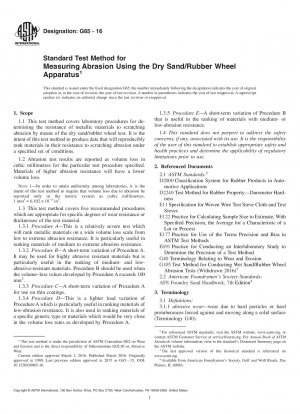ASTM G65-16
Standard Test Method for Measuring Abrasion Using the Dry Sand/Rubber Wheel Apparatus
- Standard No.
- ASTM G65-16
- Release Date
- 2016
- Published By
- American Society for Testing and Materials (ASTM)
- Status
- Replace By
- ASTM G65-16e1
- Latest
- ASTM G65-16(2021)
- Scope
5.1 The severity of abrasive wear in any system will depend upon the abrasive particle size, shape, and hardness, the magnitude of the stress imposed by the particle, and the frequency of contact of the abrasive particle. In this practice these conditions are standardized to develop a uniform condition of wear which has been referred to as scratching abrasion (1 and 3). The value of the practice lies in predicting the relative ranking of various materials of construction in an abrasive environment. Since the practice does not attempt to duplicate all of the process conditions (abrasive size, shape, pressure, impact, or corrosive elements), it should not be used to predict the exact resistance of a given material in a specific environment. Its value lies in predicting the ranking of materials in a similar relative order of merit as would occur in an abrasive environment. Volume loss data obtained from test materials whose lives are unknown in a specific abrasive environment may, however, be compared with test data obtained from a material whose life is known in the same environment. The comparison will provide a general indication of the worth of the unknown materials if abrasion is the predominant factor causing deterioration of the materials.
1.1 This test method covers laboratory procedures for determining the resistance of metallic materials to scratching abrasion by means of the dry sand/rubber wheel test. It is the intent of this test method to produce data that will reproducibly rank materials in their resistance to scratching abrasion under a specified set of conditions.
1.2 Abrasion test results are reported as volume loss in cubic millimetres for the particular test procedure specified. Materials of higher abrasion resistance will have a lower volume loss.
Note 1: In order to attain uniformity among laboratories, it is the intent of this test method to require that volume loss due to abrasion be reported only in the metric system as cubic millimetres. 18201;mm38201;=8201;6.1028201;×8201;10−5 in3.
1.3 This test method covers five recommended procedures which are appropriate for specific degrees of wear resistance or thicknesses of the test material.
1.3.1 Procedure A—This is a relatively severe test which will rank metallic materials on a wide volume loss scale from low to extreme abrasion resistance. It is particularly useful in ranking materials of medium to extreme abrasion resistance.
1.3.2 Procedure B—A short-term variation of Procedure A. It may be used for highly abrasive resistant materials but is particularly useful in the ranking of medium- and low-abrasive-resistant materials. Procedure B should be used when the volume–loss values developed by Procedure A exceeds 100 mm3.
1.3.3
ASTM G65-16 Referenced Document
- ASTM D2000 Standard Classification System for Rubber Products in Automotive Applications
- ASTM D2240 Standard Test Method for Properties of Rubber &8212; Durometer Hardness*, 2024-04-20 Update
- ASTM E11 Standard Specification for Wire Cloth and Sieves for Testing Purposes
- ASTM E122 Standard Practice for Calculating Sample Size to Estimate, With a Specified Tolerable Error, the Average for Characteristic of a Lot or Process
- ASTM E177 Standard Practice for Use of the Terms Precision and Bias in ASTM Test Methods
- ASTM E691 Standard Practice for Conducting an Interlaboratory Study to Determine the Precision of a Test Method
- ASTM G105 Standard Test Method for Conducting Wet Sand/Rubber Wheel Abrasion Tests
- ASTM G40 Standard Terminology Relating to Wear and Erosion
ASTM G65-16 history
- 2021 ASTM G65-16(2021) Standard Test Method for Measuring Abrasion Using the Dry Sand/Rubber Wheel Apparatus
- 2016 ASTM G65-16e1 Standard Test Method for Measuring Abrasion Using the Dry Sand/Rubber Wheel Apparatus
- 2016 ASTM G65-16 Standard Test Method for Measuring Abrasion Using the Dry Sand/Rubber Wheel Apparatus
- 2015 ASTM G65-15 Standard Test Method for Measuring Abrasion Using the Dry Sand/Rubber Wheel Apparatus
- 2004 ASTM G65-04(2010) Standard Test Method for Measuring Abrasion Using the Dry Sand/Rubber Wheel Apparatus
- 2004 ASTM G65-04 Standard Test Method for Measuring Abrasion Using the Dry Sand/Rubber Wheel Apparatus
- 2000 ASTM G65-00e1 Standard Test Method for Measuring Abrasion Using the Dry Sand/Rubber Wheel Apparatus
- 2000 ASTM G65-00 Standard Test Method for Measuring Abrasion Using the Dry Sand/Rubber Wheel Apparatus

Copyright ©2024 All Rights Reserved